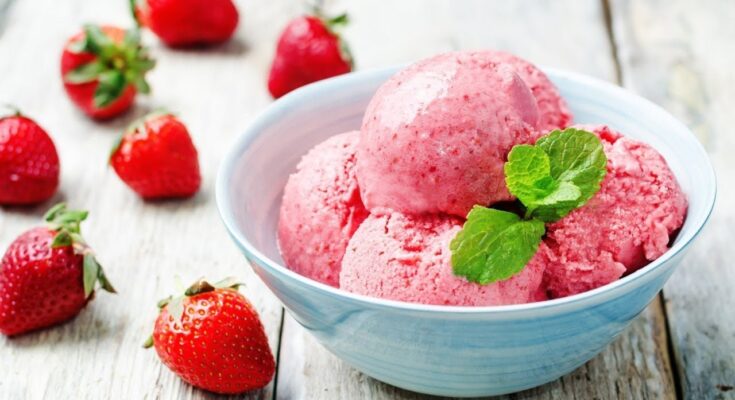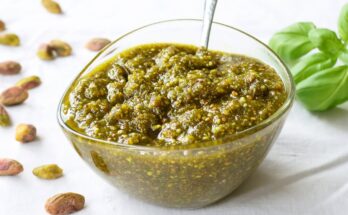Vegan Ice Cream Recipe: If you’ve ever been hit with a craving for something sweet, cold, and creamy—but want to skip the dairy—vegan ice cream is your ultimate go-to. It’s no longer a fringe health trend. Vegan ice cream has gone mainstream, loved not only by vegans but also by those with lactose intolerance, health-conscious foodies, and pretty much anyone looking to indulge a little cleaner.
Unlike traditional ice cream, which relies heavily on dairy-based milk and cream, vegan ice cream uses plant-based alternatives that still manage to deliver a rich, creamy texture. Think coconut milk, cashew cream, almond milk, or even bananas. But it’s not just about ditching the dairy—vegan ice cream opens the door to exciting flavor combinations and natural ingredients that you may not have explored before.
So whether you’re a lifelong vegan or just dipping your toes into the dairy-free world, this step-by-step guide is your ticket to creating your own scoop of heaven. No chemicals. No weird additives. Just pure, plant-powered deliciousness.
What is Vegan Ice Cream?
Vegan ice cream is exactly what it sounds like—ice cream made without any animal-derived ingredients. That means no cow’s milk, no cream, no eggs, and no honey. Instead, it’s crafted using plant-based milks like almond, soy, coconut, cashew, or oat, often blended with natural sweeteners, fruits, and thickeners to create a texture and taste that rivals traditional ice cream.
Here’s what makes it different:
- Base: Replaces dairy with plant-based milk.
- Sweetener: Avoids honey or refined sugars for agave, maple syrup, or dates.
- Thickener: Often uses tapioca starch, arrowroot, or guar gum instead of egg yolks.
It’s not just for vegans—anyone looking to eat cleaner, avoid lactose, or cut down on saturated fats can enjoy it. Bonus? Many vegan ice creams are also gluten-free, nut-free, and low in added sugar.
Why Choose Vegan Ice Cream Over Dairy-Based Ice Cream?
There are plenty of reasons people switch to vegan ice cream, and it’s not just about avoiding dairy.
- Healthier Ingredients: Many recipes cut out cholesterol and saturated fats.
- Better for Digestion: No lactose means less bloating and discomfort for many.
- Allergy-Friendly: Easier to create nut-free, soy-free, or gluten-free versions.
- Environmental Impact: Lower greenhouse gas emissions and water usage compared to dairy.
- Ethical Reasons: No animals harmed or exploited in the making.
Let’s not forget, homemade vegan ice cream also gives you complete control over what goes into your dessert. You can adjust the sweetness, avoid artificial flavors, and get creative with ingredients—something that’s hard to do with store-bought options.
Health and Environmental Benefits of Going Vegan
Going vegan isn’t just about personal health—it’s a move that impacts the planet, too. Dairy farming is resource-intensive. Producing a single gallon of cow’s milk requires about 1,000 gallons of water, and dairy cows are a major source of methane emissions.
Switching to plant-based milk alternatives can help:
- Reduce carbon footprint
- Save water
- Protect animal welfare
From a health perspective, plant-based diets have been linked to lower risks of heart disease, Type 2 diabetes, and certain cancers. Vegan ice cream fits right into this lifestyle. It’s a guilt-free pleasure you can enjoy without compromising your health or values.
Ingredients You’ll Need
Ready to get your scoop on? Here’s a breakdown of everything you’ll need to create your own luscious vegan ice cream at home. Don’t worry—it’s not as intimidating as it sounds. Most ingredients are easy to find and can be customized based on your taste preferences or dietary needs.
Essential Ingredients for Base
Let’s start with the foundation—your creamy, dreamy base.
- Coconut Milk (Full-Fat): This is your best bet for super creamy texture. Make sure it’s canned and not the kind in a carton.
- Almond Milk or Oat Milk: Great for lighter versions. Not as creamy as coconut milk but still delicious.
- Cashew Cream: Blend soaked cashews with water for a velvety base.
- Frozen Bananas: Naturally sweet and creamy; perfect for a quick soft-serve.
Each base comes with its own flavor profile and texture, so feel free to mix and match!
Natural Sweeteners Options
Skip the refined sugar and go for:
- Maple Syrup
- Agave Nectar
- Medjool Dates (blended)
- Coconut Sugar
- Stevia (if low-cal is your goal)
Sweetness levels are subjective, so taste as you go.
Flavoring and Add-Ins
Here’s where it gets fun.
- Vanilla Extract or Vanilla Bean Paste
- Cocoa Powder or Melted Vegan Chocolate
- Instant Coffee or Espresso Powder
- Nut Butters (peanut, almond, cashew)
- Fruit Purees (mango, strawberry, blueberry)
Chocolate, Fruits, and Nut Options
Toss these in after blending for texture and excitement:
- Chopped Dark Chocolate or Chocolate Chips
- Roasted Nuts (pistachios, pecans, walnuts)
- Fresh or Frozen Berries
- Coconut Flakes
- Caramel Swirls (made from dates and nut butter)
Vegan-Friendly Binding Agents (Gums/Starches)
To improve creaminess and prevent iciness:
- Arrowroot Powder
- Cornstarch
- Xanthan Gum
- Guar Gum
You’ll only need a teaspoon or two, and they make a world of difference.
Kitchen Tools Required
Ice Cream Maker vs No-Churn Methods
Before diving into the recipe, let’s talk about your setup. Do you need an ice cream maker to churn out smooth, scoopable vegan ice cream? Not necessarily.
Ice Cream Maker Pros:
- Produces ultra-smooth, creamy texture
- Speeds up the freezing process
- Ideal for large batches
- Consistent results every time
Cons:
- Can be pricey
- Requires storage space
- Needs pre-freezing or refrigerant
No-Churn Method Pros:
- No special equipment needed
- Easy and fast to prepare
- Perfect for small kitchens
Cons:
- May form ice crystals without frequent stirring
- Takes longer to freeze
- Texture may be slightly softer or grainier
If you’re a beginner, start with the no-churn method—you can always upgrade to an ice cream maker later if you get hooked (and trust us, you probably will).
Recommended Blenders and Mixers
Blending is where the magic starts. You’ll want a good-quality blender that can pulverize ingredients into a silky base.
Best tools for the job:
- High-Speed Blender (like Vitamix or Ninja): Perfect for making creamy cashew bases or banana blends.
- Food Processor: Ideal for banana-based or chunky mix-ins.
- Hand Mixer or Stand Mixer: Great for whipping air into the mix for lightness (especially in no-churn recipes).
Pro tip: Chill your blender jar and mixing bowl in the freezer for 15 minutes before starting—this helps keep everything cold, reducing the chances of melting during prep.
Step-by-Step Guide to Making Vegan Ice Cream
Now the fun part begins—rolling up your sleeves and actually making your vegan ice cream from scratch. Follow these easy steps, and you’ll be licking the spoon in no time.
Step 1: Choose Your Base – Coconut Milk, Almond Milk, or Oat Milk
Start with a creamy, plant-based base like full-fat coconut milk for richness or almond/oat milk for a lighter version. Use about 2 cups for one batch.
Step 2: Add Natural Sweeteners Like Maple Syrup or Dates
Sweeten naturally with ¼ cup maple syrup, agave, or blended dates. This keeps it vegan and refined sugar-free.
Step 3: Blend Until Smooth and Creamy
Combine your base, sweetener, and a splash of vanilla extract in a blender. Blend until silky smooth.
Step 4: Add Flavor and Mix-Ins
Stir in cocoa powder, fruit purée, or peanut butter for flavor. Add chocolate chips, nuts, or cookie pieces for texture.
Step 5: Freeze and Stir Occasionally (If No-Churn)
Pour into a container and freeze for 4–6 hours, stirring every 30–60 minutes to prevent ice crystals. Scoop and enjoy—creamy, dreamy, and 100% plant-based!
Tips for Perfect Vegan Ice Cream
Even though it’s relatively simple to make, vegan ice cream can be finicky if you’re not careful. Here are some pro tips to make sure every batch is a winner.
Texture Troubleshooting Tips
Issue: Ice cream is icy, not creamy
Fix: Increase fat content (use more coconut cream, nut butter, or avocado)
Issue: Too hard after freezing
Fix: Add a tablespoon of alcohol (vodka or bourbon) to lower freezing point
Issue: Too soft
Fix: Add a teaspoon of starch (arrowroot or tapioca) to thicken during blending
Issue: Gritty or grainy
Fix: Blend longer and soak any nuts or dates before using
Balancing Sweetness and Creaminess
The trick to a perfect scoop is all about balance.
- Use full-fat plant milks for creaminess (skim-style will turn icy)
- Sweeten slightly more than you think, as freezing mutes sweetness
- Blend in coconut oil or nut butters for silkier texture
- Avoid overloading on mix-ins, which can disrupt the creamy flow
Keeping Ice Crystals at Bay
Nothing ruins a bowl of ice cream like biting into a mouthful of ice.
Avoid this by:
- Blending well to emulsify all ingredients
- Adding a small amount of corn syrup, which reduces crystallization
- Stirring frequently during the initial freeze
- Using airtight, insulated containers
- Not overfilling the container—air circulation helps maintain consistency
5 Popular Vegan Ice Cream Flavors to Try
Let’s take your new skills for a spin. These five flavor combos are guaranteed crowd-pleasers and a perfect place to start your vegan ice cream journey.
Chocolate Peanut Butter
A rich, indulgent mix of cocoa and creamy peanut butter swirls. Use full-fat coconut milk, unsweetened cocoa powder, maple syrup, and dollops of natural peanut butter. Add crushed peanuts for crunch.
Matcha Green Tea
For a sophisticated twist, use almond milk, coconut cream, maple syrup, and high-quality matcha powder. It’s earthy, slightly sweet, and utterly refreshing.
Mango Coconut
Tropical vibes only! Blend frozen mango chunks with coconut milk and a splash of lime juice. Add shredded coconut or chili flakes for an exotic kick.
Strawberry Banana
A classic that’s naturally sweet. Frozen bananas and strawberries with a hint of vanilla and a touch of lemon juice. Use oat milk for creaminess and a light, fruity base.
Salted Caramel Swirl
Blend dates with a splash of almond milk and sea salt to make a caramel sauce. Swirl into vanilla base made with cashew cream and maple syrup. It’s sweet, salty, and seriously addictive.
Storage and Shelf Life
Best Containers for Storage
Once you’ve whipped up your perfect vegan ice cream, storing it properly is key to maintaining texture and flavor. Use airtight, freezer-safe containers to avoid freezer burn and flavor loss.
Top container options:
- Silicone ice cream tubs: Flexible and easy to scoop from
- Metal loaf pans: Great for no-churn recipes, but must be tightly wrapped
- Plastic freezer containers with tight lids
- Glass jars (with headspace): Only if you’re freezing smaller portions
Pro tip: Place a piece of wax paper or plastic wrap directly on top of the ice cream before sealing the lid. This helps prevent ice crystals from forming on the surface.
How Long Vegan Ice Cream Lasts
Homemade vegan ice cream generally lasts about 1 to 2 weeks in the freezer. Unlike commercial brands that contain stabilizers and preservatives, your homemade version is more sensitive to temperature changes and air exposure.
Signs it’s time to toss it:
- Excessive ice crystals
- Changes in flavor or smell
- Hard as a rock and un-scoopable, even after softening
If you plan to store it longer, consider smaller containers to minimize air exposure with each opening.
Nutritional Breakdown
Calories, Fats, Sugars – What to Expect
Vegan doesn’t always mean low-calorie, but it does often mean cleaner calories.
Here’s a general idea of what’s in ½ cup of basic coconut milk-based vegan ice cream:
| Nutrient | Approximate Value |
|---|---|
| Calories | 180–250 |
| Fat | 10–18g |
| Saturated Fat | 8–14g |
| Sugar | 12–18g |
| Protein | 1–3g |
| Fiber | 1–2g |
Variables to consider:
- Cashew or almond bases are lower in fat
- Sweeteners significantly affect calorie count
- Banana-based versions can drop the total calories to around 100 per serving
Making It Low-Cal or Keto-Friendly
Looking to keep things lighter or low-carb? Easy.
For low-cal options:
- Use unsweetened almond or oat milk
- Skip oils and use frozen fruit (like banana or mango)
- Use stevia or monk fruit instead of syrup or sugar
For keto versions:
- Base: Almond milk or coconut cream
- Sweetener: Erythritol or monk fruit
- Add-ins: Nuts, dark chocolate, unsweetened cocoa
Just keep in mind, keto-friendly versions may be a bit icier unless you boost the fat content.
Vegan Ice Cream vs Dairy Ice Cream
Taste Comparison
Let’s get one thing straight—vegan ice cream has come a long way. Thanks to better ingredients and smart combinations, it can now compete head-to-head with dairy ice cream.
Key taste notes:
- Coconut-based: Rich, creamy, slightly tropical
- Almond-based: Lighter, subtle nutty flavor
- Cashew-based: Super smooth and neutral
- Banana-based: Naturally sweet and fruity
Many people find vegan ice cream to be more refreshing and less heavy than dairy-based varieties. And when made right, most can’t even tell the difference in blind taste tests.
Health Benefits Compared
Dairy ice cream is often loaded with saturated fats, cholesterol, and refined sugar—not to mention hormones and antibiotics, depending on the source. Vegan alternatives can drastically reduce all of those risks.
Vegan pros:
- No cholesterol
- Lower in saturated fat (except coconut)
- Easier to digest
- Naturally lactose-free
- Can be made sugar-free
It’s a treat your body won’t hate you for.
Vegan Ice Cream for Special Diets
Gluten-Free Options
Most vegan ice creams are naturally gluten-free, but if you’re celiac or sensitive, double-check your ingredients.
Watch out for:
- Cookie dough or brownie chunks (unless GF certified)
- Add-ins like cereals or graham crackers
- Some thickeners and flavorings
Stick with whole foods (nuts, fruits, pure cocoa) to stay safe.
Nut-Free Versions
If you’ve got a nut allergy, you’re not out of luck. Use these alternatives:
- Sunflower seed butter for richness
- Coconut milk or oat milk as the base
- Avocados for creamy texture
- Rice milk for light, allergen-free options
Flavor with fruits, spices (like cinnamon or cardamom), and safe chocolate or caramel swirls for that extra pop.
FAQs about Vegan Ice Cream Recipe
Can I make vegan ice cream without an ice cream maker?
Yes! Use the no-churn method. Blend your ingredients, pour into a container, and stir every 30 minutes for 2 hours while freezing to prevent iciness.
What’s the best milk to use for creamy texture?
Canned full-fat coconut milk or blended cashews give the creamiest results. For lighter versions, almond and oat milk are great too.
Can I use stevia instead of maple syrup?
Absolutely. Stevia works well, especially if you’re watching calories. Just remember that it’s much sweeter, so use sparingly.
Why is my vegan ice cream icy?
Usually due to low fat or too much water. Try adding coconut cream, nut butter, or a small amount of alcohol to reduce ice crystals.
Is vegan ice cream healthier than regular ice cream?
In most cases, yes. It has no cholesterol, can be lower in saturated fats, and is free of lactose and hormones. Plus, you can control what goes into it.
Conclusion
Vegan ice cream is more than just a substitute—it’s a treat in its own right. With the right ingredients and tools, you can create flavors that rival (and even outperform) traditional dairy versions. Whether you’re doing it for health, ethical reasons, allergies, or just curiosity, crafting your own vegan ice cream is a rewarding and surprisingly simple adventure.
Now that you have a complete, step-by-step guide, go wild with flavors, textures, and combinations. You’ll never look at store-bought ice cream the same way again.



